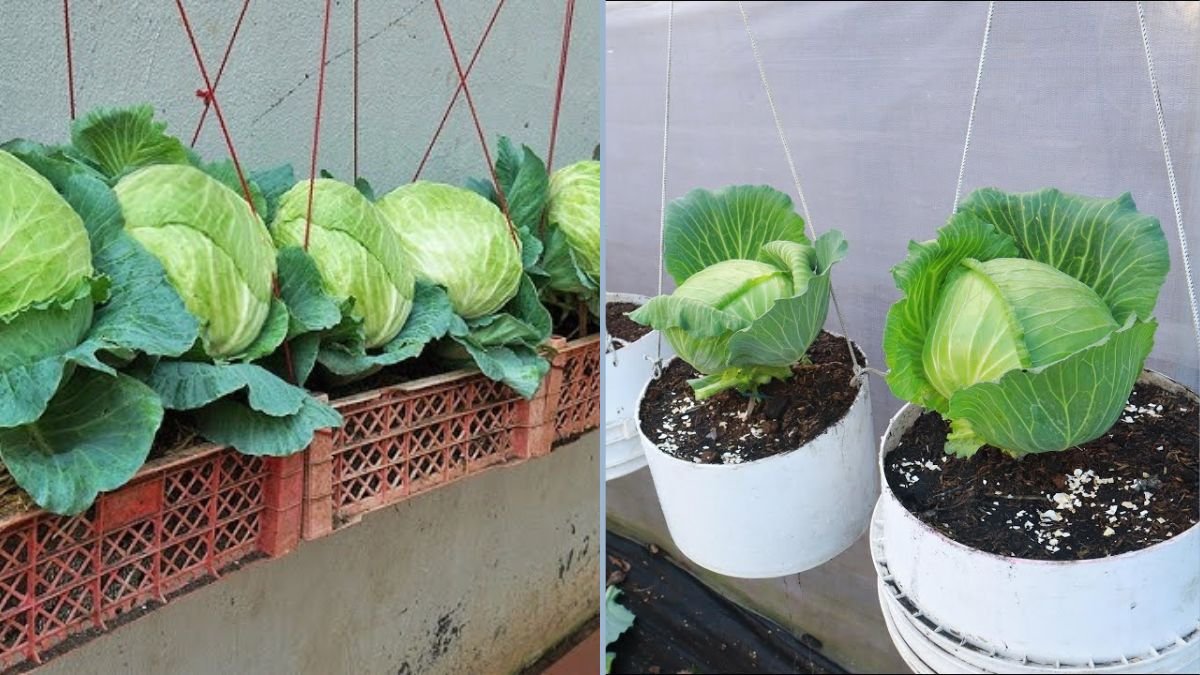Cabbage is a versatile, nutrient-rich vegetable that is a staple in kitchens worldwide. Traditionally, it is grown in rows in garden beds, but there’s a fascinating and highly efficient method that is transforming home gardening: the hanging cabbage method. This innovative technique allows gardeners to grow cabbage in vertical spaces, maximize yields, and enjoy fresh, healthy cabbage straight from their garden—all starting from seeds. In this guide, we’ll explore step-by-step how to grow cabbage from seeds using the hanging method and why this approach is gaining popularity among urban and small-space gardeners.
Why Grow Cabbage Using the Hanging Method?
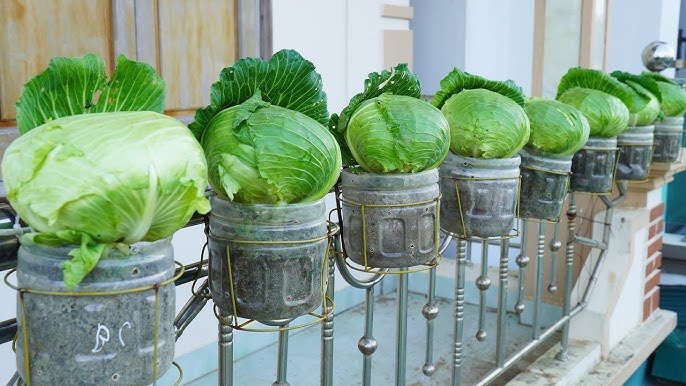
The hanging cabbage method isn’t just a novelty—it offers practical advantages that make cabbage cultivation easier and more productive:
- Space-saving: Hanging cabbage plants can grow in vertical containers, balconies, terraces, or small gardens, making it ideal for urban environments.
- Better air circulation: Elevating cabbage reduces the risk of soil-borne diseases and improves airflow around the plant.
- Ease of maintenance: Hanging plants are easier to monitor, water, and harvest without bending or stooping.
- Maximized yield: Proper hanging setups allow multiple plants to thrive in a compact area, making efficient use of space and resources.
Whether you’re a beginner gardener or an experienced grower, the hanging method can transform how you cultivate cabbage at home.
Step 1: Selecting the Right Cabbage Seeds
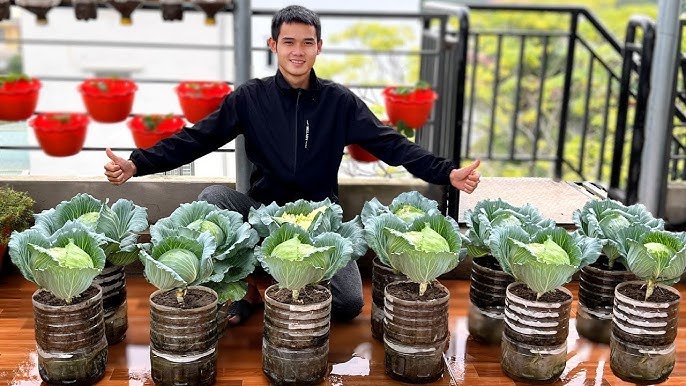
Success starts with choosing the right seeds. Consider the following:
- Variety: Choose compact or small-heading cabbage varieties that are suitable for container or vertical growth. Varieties like ‘Miniature Ball,’ ‘Green Globe,’ or ‘Red Express’ work well.
- Freshness: Use fresh, high-quality seeds from reliable sources to ensure high germination rates.
- Disease resistance: Look for seeds labeled as resistant to common cabbage pests and diseases, such as black rot or cabbage worms.
Starting with the right seeds sets the foundation for strong, healthy plants and bountiful harvests.
Step 2: Preparing Seedlings
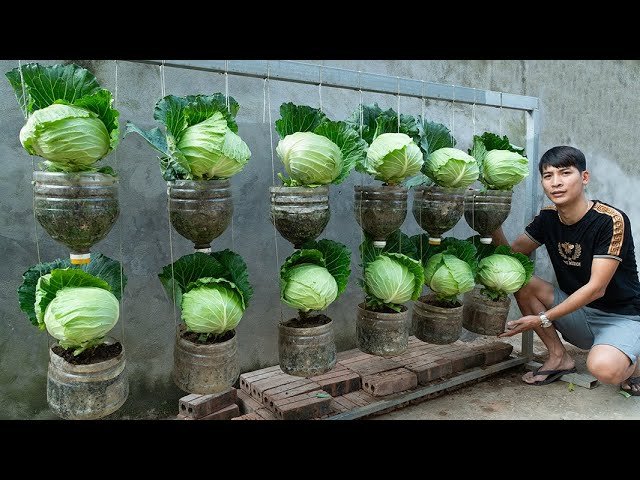
Growing cabbage from seeds requires some care during the early stages:
- Seed trays or pots: Fill trays or small pots with a light, well-draining seed-starting mix. Avoid heavy garden soil, which can impede germination.
- Planting seeds: Sow seeds about 0.5 cm deep and cover lightly with soil.
- Watering: Keep the soil consistently moist but not waterlogged. A spray bottle is ideal for gentle watering.
- Light: Place seedlings in a sunny window or under grow lights for 12–16 hours per day. Cabbage seedlings need ample light to develop strong, healthy leaves.
- Temperature: Maintain a warm environment between 18–24°C (65–75°F) for optimal germination.
Seeds typically germinate within 5–10 days, depending on the variety and environmental conditions.
Step 3: Preparing the Hanging Setup
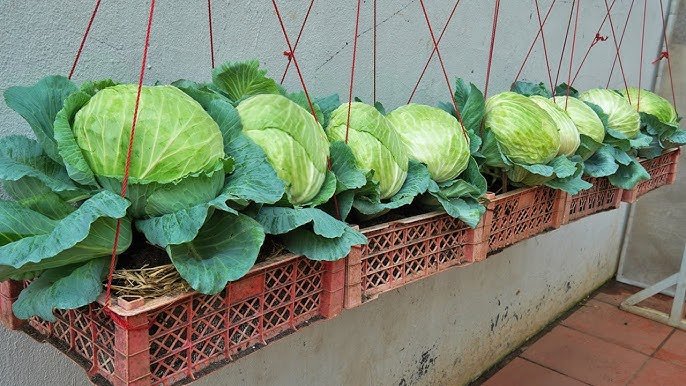
The unique aspect of this method is using hanging containers to grow cabbage. Here’s what you need:
- Containers: Use hanging baskets, vertical pots, or DIY setups made from recycled plastic bottles or fabric pockets. Ensure the containers have drainage holes at the bottom to prevent waterlogging.
- Support system: Install hooks, brackets, or strong ropes to suspend the containers. Make sure the setup can support the weight of soil, water, and growing plants.
- Soil preparation: Fill the containers with a nutrient-rich, well-draining soil mix. A recommended mix includes garden soil, compost, and perlite or vermiculite to promote aeration.
The goal is to provide a stable, elevated environment where cabbage roots can grow freely while benefiting from excellent drainage and air circulation.
Step 4: Transplanting Seedlings
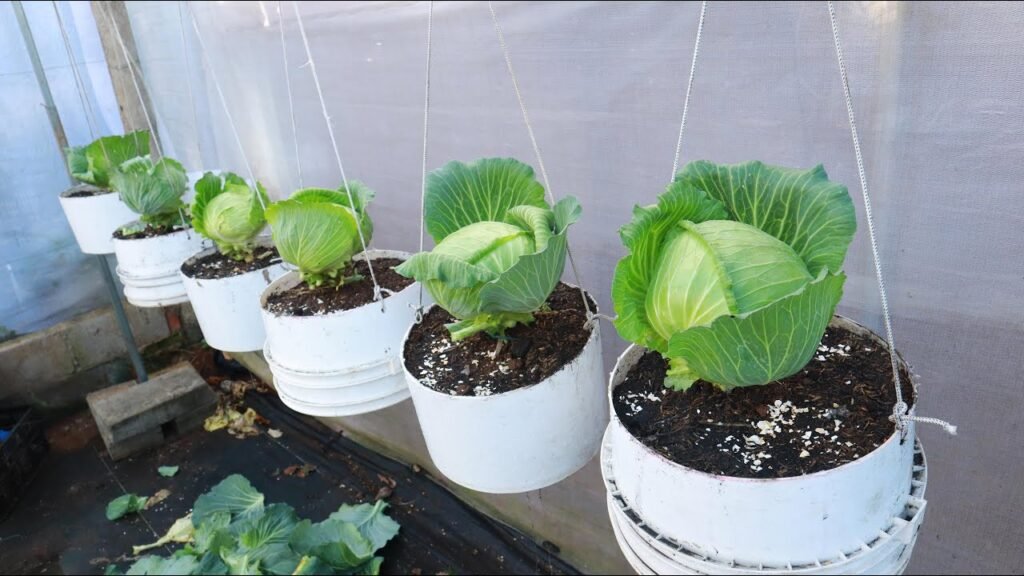
Once the seedlings have 2–3 sets of true leaves and are strong enough to handle, they’re ready for transplanting:
- Prepare the container: Fill the hanging container with the soil mix, leaving space at the top for watering.
- Transplant carefully: Gently remove seedlings from trays, taking care not to damage the roots. Plant each seedling about 10–15 cm apart, depending on the container size.
- Watering: Water immediately after transplanting to help the seedlings adjust to their new environment. Keep the soil consistently moist, especially during the first few weeks.
Hanging cabbage seedlings will quickly establish themselves, and vertical growth helps save space while reducing competition for nutrients.
Step 5: Caring for Hanging Cabbage Plants
Cabbage grown in hanging containers needs consistent care to thrive:
- Watering: Hanging plants dry out faster than in-ground plants. Water regularly, keeping the soil moist but not soggy. Consider using a drip irrigation system or self-watering pots for convenience.
- Fertilization: Use organic fertilizer every 3–4 weeks. Cabbage is a heavy feeder, so providing nutrients like nitrogen, phosphorus, and potassium ensures strong leafy growth and healthy heads.
- Pruning and support: Remove yellowing or damaged leaves to maintain plant health. Some varieties may need additional support for vertical growth.
- Pest control: Monitor for common cabbage pests like aphids, cabbage worms, and slugs. Use natural remedies such as neem oil, diatomaceous earth, or manual removal for pest management.
Proper care ensures a robust harvest and minimizes the risk of disease or stunted growth.
Step 6: Pollination and Growth
Cabbage is a self-pollinating plant, so flowers are not required for fruit formation. However, flowering is important for seed collection if you plan to propagate future crops. Most importantly, focus on:
- Leaf growth: Healthy leaves are crucial as cabbage forms its head at the center. Provide sufficient nutrients and water to support dense, compact heads.
- Sunlight: Ensure hanging cabbage receives at least 6 hours of direct sunlight per day. In partial shade, heads may form slowly or become loose.
The vertical orientation also helps prevent overcrowding, allowing each plant to access ample light and air circulation.
Step 7: Harvesting Hanging Cabbage
Cabbage is usually ready to harvest 70–120 days after sowing, depending on the variety and growing conditions. Signs of maturity include:
- Firm, dense heads
- Leaves slightly spreading outward
- A solid feel when gently squeezed
To harvest:
- Cut the cabbage head at the base using a sharp knife.
- Leave the outer leaves and stem in place; some varieties may produce secondary heads or leaves suitable for greens.
- Check regularly for any overgrown heads, as leaving them too long can affect flavor and texture.
Hanging cabbage heads are generally cleaner than ground-grown cabbage because they avoid soil contact, making harvesting easier and reducing washing time.
Advantages of the Hanging Cabbage Method
- Space efficiency: Ideal for urban gardens, balconies, and small plots.
- Reduced disease risk: Elevation and air circulation reduce soil-borne pathogens and fungal infections.
- Improved yield per plant: Vertical growth minimizes competition, allowing more nutrients and light for each plant.
- Cleaner produce: Cabbage grown off the ground remains cleaner and less prone to rot.
- Eco-friendly: Hanging setups often use recycled containers, reducing waste.
This method demonstrates how simple adjustments in planting technique can dramatically improve results in home gardening.
Tips for Success
- Choose compact varieties: Select cabbage types suited for container growth to maximize success.
- Monitor moisture: Hanging containers dry out quickly, so consistent watering is key.
- Use lightweight soil mixes: Heavy soil can stress the hanging structure and make watering difficult.
- Rotate crops: To maintain soil fertility, rotate crops or refresh soil annually.
- Experiment with vertical systems: Stack containers or use vertical pockets to grow multiple plants in limited space.
Conclusion
The hanging cabbage growing method is a game-changer for home gardeners who want fresh, nutritious cabbage without needing extensive garden space. By starting with seeds, preparing healthy seedlings, and using vertical containers with proper care, anyone can enjoy abundant cabbage harvests from even the smallest balconies or urban gardens.
Not only does this method save space and reduce disease risk, but it also makes harvesting easier and produces cleaner, healthier cabbage. Whether you are a beginner gardener or an experienced grower, the hanging method is worth trying. With careful attention to seedlings, soil, water, and nutrients, you can maximize yields and enjoy fresh cabbage all season long.
So grab some seeds, prepare your hanging containers, and start growing cabbage in a fun, efficient, and innovative way today. Your vertical garden will thank you!
